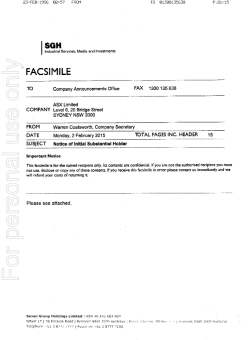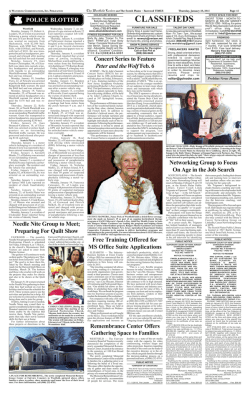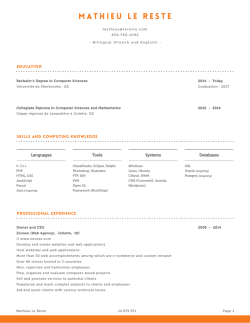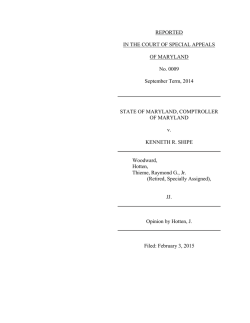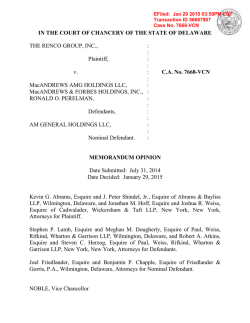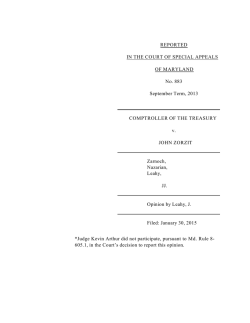
Burke Engineering v. Heritage Bank of Central
2015 IL App (3d) 140064 Opinion filed January 27, 2015 _____________________________________________________________________________ IN THE APPELLATE COURT OF ILLINOIS THIRD DISTRICT A.D., 2015 CHRISTOPHER B. BURKE ENGINEERING, ) Appeal from the Circuit Court LTD., ) of the 10th Judicial Circuit, ) Peoria County, Illinois, Plaintiff-Appellant, ) ) v. ) ) HERITAGE BANK OF CENTRAL ILLINOIS, ) Appeal No. 3-14-0064 ) Circuit No. 09-CH-589 Defendant-Appellant ) ) (Glen W. Harkins, Carol A. Harkins, Donald ) Allison, Ann Allison and Unknown Owners ) and Nonrecord Claimants, ) The Honorable ) Michael Brandt, Defendants). ) Judge, Presiding. _____________________________________________________________________________ JUSTICE CARTER delivered the judgment of the court, with opinion. Justice Wright concurred in the judgment and opinion. Justice Lytton dissented, with opinion. _____________________________________________________________________________ OPINION ¶1 The plaintiff, Christopher B. Burke Engineering, Ltd., filed a civil complaint that sought to foreclose on a mechanic's lien against multiple defendants, including Heritage Bank of Central Illinois. After the circuit court invalidated the lien and granted summary judgment in favor of Heritage Bank, the plaintiff appealed. On appeal, the plaintiff argues that the circuit court erred when it granted summary judgment in favor of Heritage Bank in that the court improperly found that: (1) no contractual relationship existed between the original owner of the property and the prospective purchaser; and (2) the plaintiff's work did not constitute an improvement to the property. We affirm. ¶2 ¶3 FACTS This is the second time this case has come before this court on appeal. The facts occurring prior to the first appeal have been set forth in Christopher B. Burke Engineering, Ltd. v. Harkins, 2011 IL App (3d) 100949-U. We will recount the facts leading up to and including that appeal only to the extent that they are essential to this appeal. ¶4 On October 29, 2009, the plaintiff filed a civil complaint against the defendants in which it sought to foreclose on a mechanic's lien. The plaintiff alleged that it had performed engineering work between April 2008 and March 2009 on certain real property for defendants Glen W. Harkins and Carol A. Harkins; in connection with that work, the plaintiff filed a mechanic's lien on May 20, 2009. ¶5 The record in this case indicates that the Harkins defendants and the plaintiff entered into a contract in mid-2008 to perform engineering work on a tract of real property not owned by the Harkins defendants. The Harkins defendants intended to purchase the property and subdivide it for residential development. At the time, the property consisted of unplatted land and two 1 platted lots. After the property was replatted, the final plat for "Crest Ridge Estates" subdivision was recorded on September 19, 2008. 1 One of these lots was replatted as lot 37 of the Crest Ridge Estates subdivision and was sold to the Allison defendants. The plaintiff performed engineering work on that lot in conjunction with the Allisons constructing a house on the lot. 2 ¶6 Initially, a motion to dismiss filed by the Allison defendants was granted on the basis that the mechanic's lien contained an inadequate legal description. The circuit court also granted a motion for summary judgment filed by Heritage Bank. On appeal, this court held that a question of fact existed with regard to whether the description was inadequate; thus, this court reversed the circuit court's judgment and remanded the case for further proceedings. Burke Engineering, 2011 IL App (3d) 100949-U, ¶¶ 12-13. ¶7 After the remand, the plaintiff settled separately with the Allisons, and the Harkins defendants filed for bankruptcy protection. Further discovery was conducted, and on October 23, 2012, Heritage Bank filed a motion for summary judgment. Four depositions were appended to the motion, two of which are pertinent to this appeal. ¶8 In her deposition, Carol Schenk stated that she sold a vacant tract of real property on August 11, 2008, for $550,000 to Glen and Carol Harkins. Prior to selling the property, she had plans of subdividing the land for residential development. Randolph and Associates had prepared a plat for her several years prior to the sale of the land. She stated that the plaintiff never performed any work for her. Through documents she signed associated with the sale of the property, Schenk attested to the property being free of, inter alia, improvements and contracts for improvements or services within the six months prior to the sale. She also stated that at no time prior to the sale did anyone approach her about having the plaintiff perform any kind of work on the property, that she had no knowledge of any work performed by the plaintiff with regard to the property, and that she never consented to Glen and Carol Harkins acting on her behalf. She did state that prior to agreeing to the sale, she had been approached by Glen Harkins, who told her that he was going to use the plaintiff to perform engineering work, but she had no knowledge of what work the plaintiff was in fact going to perform. She did state, though, that 3 she was aware prior to closing that the plaintiff was preparing the preliminary and final plats and other associated work necessary for the layout of the subdivision. ¶9 In his deposition, Glen Harkins stated that he had worked as a contractor for over 35 years and, prior to the purchase of Schenk's property, he had bought two other properties that he subdivided and developed residentially. Glen stated that he contacted the plaintiff in late April 2008 to prepare a preliminary plat for the Crest Ridge Estates subdivision. He stated that he received the preliminary plat around July 15, 2008, when he agreed to purchase the property. When he was asked if he intended the plaintiff's work to be the basis for determining whether the development was viable, he responded, "[n]ot really, no." Glen believed that the project would be viable based on one of his prior developments, but he did state that if the plaintiff could not have included in the plat the number of lots that he wanted, he would not have purchased the property. He later recanted that statement and said that he knew he could get the number of lots he wanted out of the property. Glen also stated that after he agreed to purchase the property, he approached the plaintiff to prepare the final plat. While Glen stated that he believed that he received the final plat from the plaintiff before the closing on August 11, 2008, an issue with the existence of a wetland on the property was discovered subsequent to the closing that necessitated some changes to the plat. Additionally, one house was built on a lot on the property for which the plaintiff had performed the "lot work," and the plaintiff had also performed engineering work regarding the planning of sewers and roads on the property. However, Glen further stated that in February 2009, due to the state of the economy, he decided not to pursue development of the property. At some point prior to that decision, he had told the plaintiff to stop all work related to the property. 4 ¶ 10 When asked about his association with Schenk, Glen stated that: (1) he never intended to work with her to develop the property; (2) he never intended to work on her behalf to develop the property; (3) she never gave him authorization to act on her behalf to develop the property; (4) he did not recall giving her any information about the plaintiff or the work that the plaintiff did for Harkins, but she did know that work was being performed prior to the closing and did not object to it; (5) he never intended her to receive any benefit from the plaintiff's work; (6) to his knowledge, she never received any benefit from the plaintiff's work; and (7) the plaintiff's work did not provide any physical improvements to the property, but the plaintiff was physically on the property at some point during the summer of 2008. ¶ 11 On December 18, 2013, the circuit court held a hearing on Heritage Bank's motion for summary judgment. The court heard arguments and took the matter under advisement and then issued a written decision the following day that granted the motion. In so ruling, the court found that "the uncontroverted facts show that there was not an improvement to the land and there was no encouragement or inducement by the landowner whatsoever." The plaintiff appealed. ¶ 12 ANALYSIS ¶ 13 On appeal, the plaintiff argues that the circuit court erred when it granted summary judgment in favor of Heritage Bank. Specifically, the plaintiff contends that the court erred "in invalidating Plaintiff's mechanics lien for failure to demonstrate a contractual relationship with a party the owner knowingly permitted to contract" and "in invalidating Plaintiff's mechanics lien for failure to demonstrate an improvement to the property." ¶ 14 Summary judgment is appropriate "if the pleadings, depositions, and admissions on file, together with the affidavits, if any, show that there is no genuine issue of material fact and that the moving party is entitled to a judgment as a matter of law." 735 ILCS 5/2-1005(c) (West 5 2012). We review a circuit court's summary judgment ruling de novo. Williams v. Manchester, 228 Ill. 2d 404, 417 (2008). ¶ 15 In relevant part, section 1(a) of the Mechanics Lien Act (Act) provides: "Any person who shall by any contract or contracts, express or implied, or partly expressed or implied, with the owner of a lot or tract of land, or with one whom the owner has authorized or knowingly permitted to contract, to improve the lot or tract of land or for the purpose of improving the tract of land, *** is known under this Act as a contractor and has a lien upon the whole of such lot or tract of land and upon adjoining or adjacent lots or tracts of land of such owner constituting the same premises and occupied or used in connection with such lot or tract of land as a place of residence or business[.]" 770 ILCS 60/1(a) (West 2012). Further, the Act defines "improve" as follows: "to furnish labor, services, material, fixtures, apparatus or machinery, forms or form work in the process of construction where cement, concrete or like material is used for the purpose of or in the building, altering, repairing or ornamenting any house or other building, walk or sidewalk, whether the walk or sidewalk is on the land or bordering thereon, driveway, fence or improvement or appurtenances to the lot or tract of land or connected therewith, and upon, over or under a sidewalk, street or alley adjoining; or fill, sod or excavate such lot or tract of land, or do landscape work thereon or therefor; or raise or lower any house thereon or remove any house thereto, or remove any house or other structure therefrom, or perform any services or incur any expense as an architect, structural engineer, professional engineer, land surveyor or property manager in, for or on a lot or 6 tract of land for any such purpose; or drill any water well thereon; or furnish or perform labor or services as superintendent, time keeper, mechanic, laborer or otherwise, in the building, altering, repairing or ornamenting of the same; or furnish material, fixtures, apparatus, machinery, labor or services, forms or form work used in the process of construction where concrete, cement or like material is used, or drill any water well on the order of his agent, architect, structural engineer or superintendent having charge of the improvements, building, altering, repairing or ornamenting the same." 770 ILCS 60/1(b) (West 2012). ¶ 16 Because mechanics' liens are not recognized by the common law or equity, the statute giving rise to the creation of the lien must be strictly construed. Watson v. Watson, 218 Ill. App. 3d 397, 399 (1991); First Bank of Roscoe v. Rinaldi, 262 Ill. App. 3d 179, 187 (1994). The party seeking to enforce a lien has the burden of proving that it has met each and every one of the statute's requirements. Watson, 218 Ill. App. 3d at 399-400; Mostardi-Platt Associates, Inc. v. Czerniejewski, 399 Ill. App. 3d 1205, 1209 (2010). ¶ 17 "The purpose of the Act is to permit a lien upon premises where a benefit has been received by the owner and where the value or condition of the property has been increased or improved by reason of the furnishing of labor and materials." (Emphasis in original.) Watson, 218 Ill. App. 3d at 399; Mostardi-Platt Associates, 399 Ill. App. 3d at 1209. In determining whether a mechanic's lien is valid, a court focuses on whether the work performed actually enhanced the value of land. Mostardi-Platt Associates, 399 Ill. App. 3d at 1211; Watson, 218 Ill. App. 3d at 400; L.J. Keefe Co. v. Chicago & Northwestern Transportation Co., 287 Ill. App. 3d 119, 122 (1997); D.M. Foley Co. v. North West Federal Savings & Loan Ass'n, 122 Ill. App. 3d 411, 415 (1984). 7 ¶ 18 Our review of the record in this case reveals no error in the circuit court's finding that the plaintiff failed to establish that its work improved the property at issue. The pleadings and depositions on file indicate that the plaintiff performed work related to the platting of the Crest Ridge Estates subdivision. That work began during the time that Schenk owned the property and extended into the time that the Harkins defendants owned the property. The final plat for the property was recorded in September 2008 and only one lot was actually sold, which was to the Allisons, with whom the plaintiff settled separately. The remainder of the property remained untouched, as the project was abandoned in early 2009. While the product of the plaintiff's work may have been required of the Harkins defendants by Heritage Bank to secure financing for the proposed development, and also by the municipality before the property could in fact be developed, the plaintiff has not pointed to any case in which the recording of a final plat as the result of an engineering company's work was found to enhance the value of the land, and we have likewise found no such case. See, e.g., Mostardi-Platt Associates, 399 Ill. App. 3d at 1211 (rejecting an argument that certain preliminary services constituted improvements under the Act "because they [were] 'necessary' for the construction of a coal gasification facility on the property"). 2 Under the circumstances of this case, we hold that the services provided by the plaintiff for the Harkins defendants in fact did not constitute an improvement to the property under the Act. 3 See Mostardi-Platt Associates, 399 Ill. App. 3d at 1211. Thus, we hold that the circuit court did not err when it granted summary judgment in favor of Heritage Bank. 4 2 We also find it noteworthy that the Act does not mention developers in section 1. See Rinaldi, 262 Ill. App. 3d at 186 (finding that because the Act did not extend to individuals who contract to develop land or who perform services of a developer, such services were not lienable under the Act). 3 While pre-1935 appellate court decisions are not precedential (Bryson v. News America Publications, Inc., 174 Ill. 2d 77, 95 (1996)), we acknowledge that in a 1922 case, the appellate court held that an architect's plans for a 8 ¶ 19 CONCLUSION ¶ 20 The judgment of the circuit court of Peoria County is affirmed. ¶ 21 Affirmed. ¶ 22 JUSTICE LYTTON, dissenting. ¶ 23 I disagree with the majority’s conclusion that plaintiff was not entitled to a lien for his services in this case. I would find that the services plaintiff provided as an engineer in creating a plat for the proposed development fall squarely within the Act even if the proposed development was not completed. I would conclude that while plaintiff is entitled to a lien for some of the work he performed, a remand is necessary to determine the proper amount of his lien. ¶ 24 “The paramount objective in construing a statute is to give effect to the intent of the legislature.” Petroline Co. v. Advanced Environmental Contractors, Inc., 305 Ill. App. 3d 234, 237 (1999). In order to determine legislative intent, courts construe a statute as a whole so that no term is rendered superfluous or meaningless. Central Illinois Electrical Services, L.L.C. v. Slepian, 358 Ill. App. 3d 545, 549 (2005). The purpose of the legislature should be gathered from the entire statute. Petroline, 305 Ill. App. 3d at 237. ¶ 25 The purpose of the Act is to protect those who, in good faith, furnish material or labor for the improvement of real property. Mostardi-Platt, 399 Ill. App. 3d at 1209. “Rights under the Act are in derogation of the common law, and the steps necessary to invoke those rights must be strictly construed.” National City Mortgage v. Hillside Lumber, Inc., 2012 IL App (2d) 191292, building "were merely for the purpose of furnishing defendant with information tending to show the possibilities of such an improvement" and were not lienable under the Act (Ohrenstein v. Howell, 227 Ill. App. 215, 219 (1922)). 4 Our ruling on the improvement issue obviates the need to address the plaintiff's argument regarding the "knowingly permitted" issue. 9 ¶ 6. However, once a contractor has strictly complied with the requirements, the Act is to be liberally construed to accomplish its purpose. Id. ¶ 26 When the legislature amends a statute, it is presumed to be creating new law, not engaging in a useless act. In re Petition of K.M., 274 Ill. App. 3d 189, 202 (1995). A statute should not be construed so that amendatory language is rendered superfluous. Id. ¶ 27 ¶ 28 I First, I believe that the trial court and majority erred in requiring plaintiff to prove that his services as a professional engineer improved the subject property. The appropriate inquiry is whether plaintiff’s services were provided for the purpose of improving the subject property. ¶ 29 When the Act was created, only architects, superintendents, timekeepers, mechanics and laborers were entitled to liens under the Act. See 1903 Ill. Laws 230. In 1913, the legislature amended the statute to allow liens for services performed by structural engineers. 1913 Ill. Laws 400. Then, in 1951, the legislature amended the Act to allow liens for the performance of services by professional engineers and land surveyors. 1951 Ill. Laws 1358. ¶ 30 Now, under the Act, “an architect, structural engineer, professional engineer, land surveyor or property manager” who performs “any services or incur[s] any expense” for or on a tract of land for the purpose of improving the tract of land is entitled to a lien. 770 ILCS 60/1(b) (West 2012). Architects and engineers are treated similarly in determining whether they are entitled to mechanic’s liens. See Dunham Associates, Inc. v. Group Investments, Inc., 223 N.W.2d 376, 380 (Minn. 1974) (finding “no rational distinction” between the services of an architect and an engineer under mechanic’s lien statute); Kimberly C. Simmons, Architect’s Services As Within Mechanics’ Lien Statute, 31 A.L.R.5th 664, 677 (1995) (“many jurisdictions, in deciding whether services performed are ones for which a mechanic’s lien may be granted, 10 treat engineers and engineering firms in much the same way as they do architects”). Both architectural and engineering services “la[y] the groundwork for the physical enhancement to real property.” Weber v. Pascarella Mason Street, LLC, 930 A.2d 779, 785 (Conn. App. Ct. 2007). ¶ 31 Our supreme court has ruled that a mechanic’s lien is allowed for the services of an architect even though the building for which the architect drafted plans was never constructed. See Freeman v. Rinaker, 185 Ill. 172 (1900); Crowen v. Meyer, 342 Ill. 46 (1930). In Freeman, the court ruled that an architect who drew plans for a building was entitled to lien even though “nothing was done towards the actual construction of the building.” Freeman, 185 Ill. at 175. The court reasoned that the Act requires that the architect’s services be provided “for the purpose of building any house” and that “[w]hen an architect draws plans and specifications for a building, *** he performs services for the purpose of building it.” Id. at 176. ¶ 32 Similarly, in Crowen, the court rejected the property owners’ argument that an architect who prepared plans and specifications for a building that was never constructed was not entitled to a mechanic’s lien on their property. Crowen, 342 Ill. at 52. The court ruled that the language of the Act “gives to the architect a lien for services rendered for the purpose of improving property.” Id. Thus, the architect was entitled to a lien for the plans and specifications he prepared for a building that was never constructed. Id. ¶ 33 The Second District also ruled that an architect can assert a lien for plans prepared but never put into use by the property owner. See Butler v. Metz, Train, Olson & Youngren, Inc., 62 Ill. App. 3d 424 (1978). In Butler, the court ruled that an architect was entitled to a lien for plans he furnished for two buildings even though only one building was built. Id. at 432. The court 11 stated: “The filing of a mechanic’s lien is not only proper and legal but is often the only practical and expedient way a contractor or architect can enforce his claim.” Id. ¶ 34 The Act, thus, allows a lien to be imposed regardless of whether the services actually “improved” the land (In re California Steel Co., 21 B.R. 383, 386 (Bankr. N.D. Ill. 1982) (citing Freeman, 185 Ill. at 175-76, and Butler, 62 Ill. App. 3d at 432-33)) as long as the services were performed “for the purpose of improving” a tract of land. See Freeman, 185 Ill. at 176; Crowen, 342 Ill. at 52. ¶ 35 Preliminary engineering work is performed for the purpose of improving property. See Midland Mortgage Co. v. Sanders England Investments, 682 P.2d 748, 749-50 (Okla. 1984); Ramey Kemp & Associates, Inc. v. Richmond Hills Residential Partners, LLC, 737 S.E.2d 420, 427-28 (N.C. Ct. App. 2003); Mutual Savings Ass’n v. Res/Com Properties, L.L.C., 79 P.3d 184, 192 (Kan. Ct. App. 2003); see also Frank Pisano & Associates v. Taggart, 105 Cal. Rptr. 414, 427 (Cal. Ct. App. 1972) (“significant engineering services,” including drawing and recording a subdivision map, “constituted a work of improvement upon the property”). This is true even if no physical building is ever erected. See Chas. H. Sells, Inc. v. Chance Hills Joint Venture, 622 N.Y.S.2d 422, 424 (N.Y. Sup. Ct. 1995) (engineering services that enabled property to receive municipal approval constituted a “permanent improvement”); Nolte v. Smith, 11 Cal. Rptr. 261, 262 (Cal. Dist. Ct. App. 1961) (engineer’s services, which included surveying, planning, and preparing subdivision map, constituted “constructive improvement” to the project even though project was not completed). ¶ 36 Architects and engineers who prepare preliminary plans for property are entitled to a mechanic’s liens even if construction is never begun on the property through no fault of their own. See Crowen, 342 Ill. at 52; Freeman, 185 Ill. at 176; Cubit Corp. v. Hausler, 1992-NMSC- 12 050, ¶ 15, 845 P.2d 125; Tuttle & Associates, Inc. v. Gendler, 467 N.W.2d 881, 884-85 (Neb. 1991); Dunham Associates, Inc. v. Group Investments, Inc., 223 N.W.2d 376, 383 (Minn. 1974); Zions First National Bank v. Carlson, 464 P.2d 387, 388 (Utah 1970); Altom Construction Co. v. BB Syndication Services, Inc., 359 S.W.3d 146, 154 (Mo. Ct. App. 2012); Merrick & Co. v. Estate of Verzuh, 987 P.2d 950, 952 (Colo. App. 1999); Design Associates, Inc. v. Powers, 356 S.E.2d 819, 821 (N.C. Ct. App. 1987); O’Hara v. Architects Hartung & Ass’n, 326 N.E.2d 283, 287 (Ind. Ct. App. 1975); Warshaw v. Pyms, 266 So. 2d 355, 356 (Fla. Dist. Ct. App. 1972); Chas. H. Sells, 622 N.Y.S.2d at 424. ¶ 37 Professionals who design buildings and developments should not be penalized for an owner’s choice not to proceed with a construction project. See Cubit Corp., 1992-NMSC-050, ¶ 50, 845 P.2d 125; Seracuse Lawler & Partners, Inc. v. Copper Mountain, 654 P.2d 1328, 1331 (Colo. App. 1982); Chas H. Sells, 622 N.Y.S.2d at 424; In re Morrell, 42 B.R. 973, 978 (Bankr. N.D. Cal. 1984). “If a landowner fails to take a project through to completion, for whatever reason, the claims for work done to improve the property are no less entitled to the benefits of this [mechanic’s lien] statute.” Chas H. Sells, 622 N.Y.S.2d at 423. It would be “manifestly unjust” to deny architects and engineers liens because the person with whom they contracted did not complete the project as planned. Morrell, 42 B.R. at 979. “[T]hey can do nothing themselves to begin work on the ground to make their liens valid.” Id. One court stated: “For the purposes of the mechanics’ lien law, the claimant is not to be charged with another’s mistake in judgment which results in the noncompletion of the project. To hold otherwise would defeat the purpose of the statute. An owner could easily shutdown a project before substantial completion, and, arguing that a partially completed project represents no value enhancement to the property, he 13 could thereby leave those who worked on the project without any lien remedies.” Seracuse Lawler, 654 P.2d at 1331. ¶ 38 Because architects and engineers rely on their entitlement to a lien, lien statutes should not be construed so narrowly as to defeat their intent and purpose. Cubit Corp., 1992-NMSC050, ¶ 16, 845 P.2d 125. “To do so would undermine the purpose of insuring payment to those who render services toward a project that has been abandoned through no fault of a claimant.” Id. ¶ 39 The majority makes passing reference in footnotes to two cases to support its decision to affirm the trial court’s denial of plaintiff’s lien. See supra ¶ 18 nn. 2, 3. In Ohrenstein, a case lacking any precedential value, the court ruled that architects who prepared sketches for a property owner were not entitled to a lien because the sketches “were not for the improvement of the lot, but were merely for the purpose of furnishing defendant with information tending to show the possibilities of such improvement.” Ohrenstein, 227 Ill. App. at 219. Unlike the architects’ sketches in Ohrenstein, which were never used by the property owner, the documents prepared by plaintiff, including a final plat of the subdivision, were used by Harkins to obtain financing and municipal approval for the subdivision. The work completed by plaintiff was performed for the purpose of improving the property, not just to inform Harkins about what improvements were possible. ¶ 40 The other case cited by the majority does not support its decision to deny plaintiff a lien in this case. Although the court in Rinaldi ruled that the services of a “developer” are not covered by the Act, it stated that “[u]nder the Act *** professional engineers *** who perform any service or incur any expense for any purpose are entitled to a lien.” Rinaldi, 262 Ill. App. 3d 14 at 184, 186. The court further stated that certain professionals, including engineers, can claim a lien on property even if no structure is located thereon. Id. at 185. ¶ 41 Presumably, the majority is suggesting that plaintiff’s work was akin to that of a developer. However, nothing in the record supports such a position. Unlike developers, who make things “ ‘visible or manifest’ ” (id. (quoting Webster’s Third New International Dictionary 618 (1986)), engineering services lay the groundwork for the physical enhancement of property. See New England Savings Bank v. Meadow Lakes Realty Co., 706 A.2d 465, 472 (Conn. 1998). Professional engineers prepare plans and specifications for construction projects and prepare plats for proposed developments. See Fireman’s Fund Insurance Co. v. SEC Donohue, Inc., 176 Ill. 2d 160, 163 (1997); Petterson v. City of Naperville, 9 Ill. 2d 233, 240 (1956); Clark v. Village of Oswego, 10 Ill. App. 3d 964, 966 (1973). ¶ 42 Plaintiff’s services in this case, including planning sewers and roads and preparing the final plat of the subdivision, were those of a professional engineer. See Petterson, 9 Ill. 2d at 240; Clark, 10 Ill. App. 3d at 966. A professional engineer is listed in the Act as one who is entitled to a lien for the services he performs and the expenses he incurs. 770 ILCS 60/1 (West 2012). Thus, plaintiff’s services fall squarely within the Act. ¶ 43 The majority’s conclusion that the services provided by plaintiff are not covered by the Act renders meaningless the legislature’s 1951 amendment that allows liens for the performance of services by “professional engineers.” The only way to give meaning to all provisions of the Act, as we must do (K.M., 274 Ill. App. 3d at 202), is to interpret the Act to include the services of plaintiff, a professional engineer, which were performed “for the purpose of improving” the property even though the project did ultimately come to fruition. See Freeman, 185 Ill. at 176; Crowen, 342 Ill. at 52. 15 ¶ 44 ¶ 45 II Next, I find that although plaintiff is entitled to a mechanic’s lien, it is necessary to remand the case to the trial court to determine the proper amount of plaintiff’s lien. ¶ 46 The Act permits a lien on property where a benefit has been received by the owner of the property. See Mostardi-Platt, 399 Ill. App. 3d at 1209. The theory underlying the Act is that an owner benefited by improvements to his property should pay for the benefit when it was induced or encouraged by his acts. Id. ¶ 47 Here, the lien claimed by plaintiff covers all of the engineering work it performed, both before and after Harkins bought the property. However, Harkins and Schenck testified that plaintiff’s work was not intended to and did not benefit Schenck. Because Schenck did not benefit from plaintiff’s work, any work performed by plaintiff while Schenck owned the property should not be subject to plaintiff’s mechanic’s lien. ¶ 48 As set forth above, plaintiff’s work benefitted Harkin because it allowed him to obtain financing and municipal approval for the property and moved the land toward becoming developed. Without plaintiff’s services, the land could not have been developed. Thus, the work performed by plaintiff after Harkins purchased the property should be subject to plaintiff’s mechanic’s lien. ¶ 49 Because the record is unclear regarding when plaintiff’s services were performed, I would remand the cause to determine the proper amount of plaintiff’s mechanic’s lien. Plaintiff should have a lien only on the services performed during Harkins’ ownership of the property since only Harkins benefitted from plaintiff’s services. 16
© Copyright 2024
